#Bound for the Goldfields
Explore tagged Tumblr posts
Text
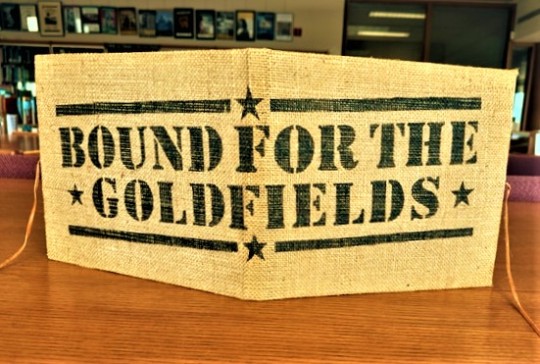
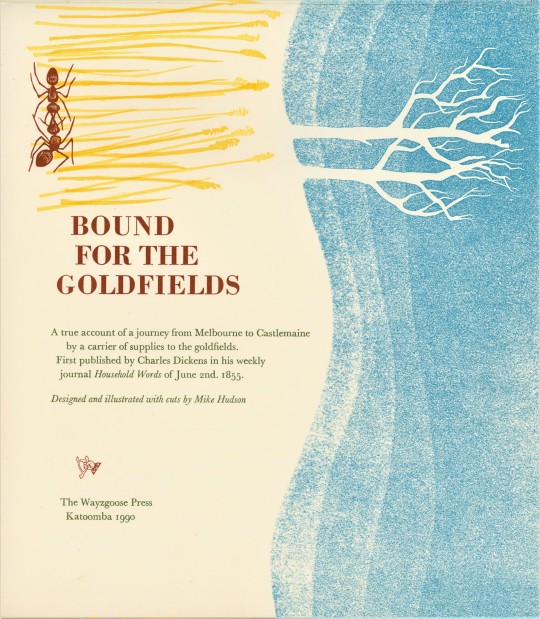



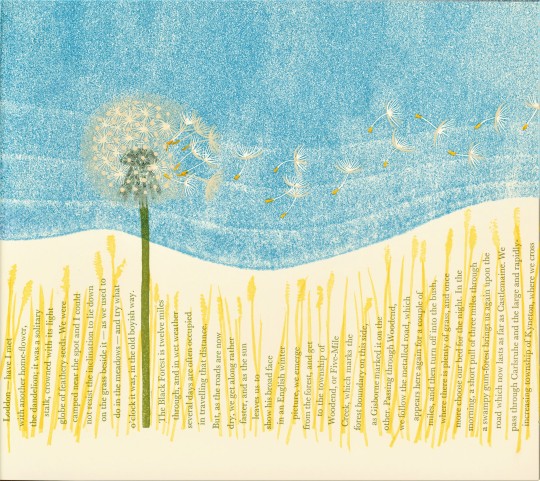

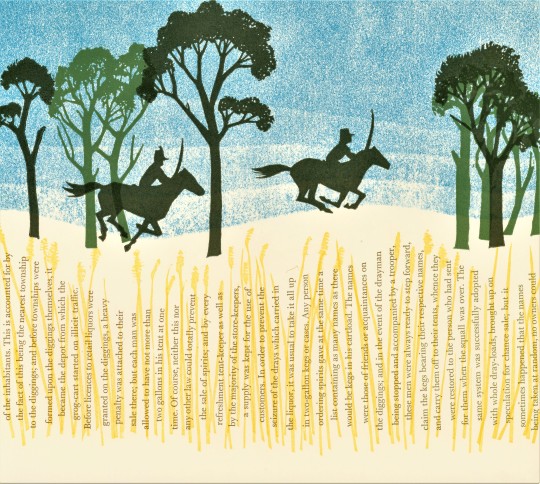


It's Fine Press Friday!
For today’s Fine Press Friday post, our subject is Bound for the Goldfields, published by the Australia-based Wayzgoose Press in 1990 in an edition of 55 copies, another gift from the estate of book artist and collector Dennis Bayuzick. The original story was written by Charles Dickens for his weekly journal Household Words in June 1855 and the Wayzgoose edition was designed and illustrated with linocuts and wood engravings by Wayzgoose founder Mike Hudson (1939-2021). Ours is a review copy, meaning that this specific book was originally sent out to someone to be reviewed for publication before it was actually distributed.
According to the title page, the story told in this book is a “true account of a journey from Melbourne to Castlemaine by a carrier of supplies to the goldfields.” A journey like this was long and harrowing, as described in the book’s text, which is printed vertically as part of the grassy landscape, and the wood/linocuts provide an excellent visualization of where the traveler physically is within the story being told. Readers will see many trees as the subject walks through forests, sees the night sky, and even the destination of the traveler as he arrives: the tents of those working in the gold fields.
This book was hand-set by Hudson's long-time partner and Wayzgoose Press co-founder Jadwiga Jarvis (1947-2021) in 14pt Monotype Baskerville and was printed on a Western Proof Press using Mohawk Letterpress Paper. Mike Hudson Bound the edition, 46 copies of which were in printed hessian fabric with leather thongs, as shown here.
View other books from the collection of Dennis Bayuzick.
View more Fine Press Friday Posts.
-- Sarah S., Special Collections Graduate Intern
#Fine Press Friday#fine press fridays#letterpress printing#fine press books#Wayzgoose Press#Bound for the Goldfields#Charles Dickens#gold mining#Mike Hudson#Jadwiga Jarvis#Monotype Baskerville#Mohawk Letterpress Paper#Western Proof Press#hessian fabric#Sarah S.
19 notes
·
View notes
Text
A selection of perfume first impressions
(Tested yesterday, over the course of multiple hours at different shops)
Sunset Hour by Goldfield & Banks— It smells like what you’d expect a tan American or Australian influencer girl to smell like. Sweet and fruity in a way that makes you say “oh I love it:)” in the very first moment you smell it, but lacking depth or anything that makes it interesting going from there. Superficially pretty, in other words.
Giardino di Boboli by Roberto Ugolini — fresh and green, uplifting. It has that extremely sophisticated freshness that is also present in the Jardins line by Hermès. Not the citrus-dominant, cool type of refreshment(which I also love), but rather green and complex (as far as I could tell on paper). There is always something multidimensional about the jardins, too. I’d probably go for those, tbh, since 400€+ isn’t quite a reasonable expense for me, but Giardino di Boboli is LOVELY and I’m sure it’s wonderful in summer.
Rouge chaotique by Byredo — the shop assistant showed it to me as an alternative to B540 sans the headache (we talked about the headache inducing quality of that fragrance) and I definitely see how it’s very similar. A deep, vibrant mush of red berries with that scratchy-sweet note coming through later on. I’m glad she found an alternative to the scent she enjoys! It showed me that I’m just not fond of the scent, it’s not just that it gives me a headache (which this version, true to her word, didn’t).
Love don’t be shy by Killian — bubblegum. The tacky, pastel pink bubblegum of your childhood. Sadly, just as linear and overpowering to me. I could detect no layers, nothing that could justify the hype to me. Apart from overpowering sweetness. Maybe it develops on skin.
Sintra by Memo Paris — definitely very close to my beloved Classique Cabaret. Orange blossoms dusted in that powdery, white sugar that clings to marshmallows, which is a dream of a concept. Very sweet, but on paper at least it had a balance that was lacking from Love don’t be shy, most likely due to the prominent role orange blossoms played here (at least to my nose). It gave me the confidence to wear Cabaret since there IS the possibility of me getting a similar scent (for a lot more money) if I ever finish the bottle.
Babycat by YSL — very likeable. At first, it seemed to me very sharp, a very regal scent that demands attention and requires a woman of posture and strength (or a man who likes slightly sweet scents). Androgynous, to make it short, in the high fashion elegance way. However, it quickly dried down into a much more demure vanilla with spices — which explains why it’s so popular, I was a little surprised since it did smell very strong at first. The spicy vanilla is of course very lovely (as was the beginning). I looked it up and there are leather notes, which of course is the way right into my heart. Unsurprisingly, I loved it (even if the beginning was a little too suited up and I’m not sure it’d suit me). If I had unlimited funds, I’d most likely buy it without second thought.
Orchidee Vanille by Van Cleef & Arpels — I wanted to try it since it’s been said to be similar to Cuir d’Orient, but I like Cuir d’Orient better. That said, it’s definitely lovely. Again, vanilla, powder, some depth, I’m bound to love it. I’d have to try it on skin, but I think the leather in Cuir d’Orient gives it that kick that makes it so special to me. Still lovely. I’d try it on skin.
L’interdit Rouge by Givenchy — this was so lovely. Wow. I really got that juicy freshness of the blood orange at the start, mixed with the tuberose. Frankly, I was blown away and very surprised. On paper, this was absolutely lovely. And I actually thought it wouldn’t be too bad in summer? Summer nights, maybe? I would have to test it ok skin since it might become oppressive, but on paper I really loved it.
L’interdit by Givenchy — I tried it again after that L’IR success. Not a first try, but it’s been a while. It smells as I remember, but more delicate, transparent, lighter than the blood orange version, which in turn is a little more refreshing, fizzier. I think the rouge is a little more interesting with that fruity aspect, which elevates it from the lovely bed of white flowers and gives it a kick. However, it IS a lovely bed of white flowers. More youthful and playful than the rouge, imo, but of course also very heady-elegant. I enjoyed it. On the next day, I do get that synthetic/bubblegum(?) note people comment on from both paper strips. I’d definitely have to test it on skin, because that note can get annoying. But it was a really nice fragrance I now want to try on skin again.
Fragrances I tested in skin
Comète by Chanel — it’s definitely a Chanel take on powders and violets. I did get that fizzy aldehyde opening, but after that initial sparkling-cool trail of stardust, it was pure lotion. Pampered skin, elevated but relaxed. All throughout, that Chanel DNA was present, which made it feel familiar — like a friend was waiting just around the corner and you could smell wafts of her. I really enjoyed wearing it, it wasn’t oppressive but present. It lasted, too, keeping me wrapped up in the scent of luxurious, elevated lotion with that beloved Chanel DNA. I do like Chanel scents, so this was very lovely to me. And again, it wasn’t overwhelming. A gentle presence (like a star, you could say, watching over you from a distance…). I felt protected, wrapped in cashmere, pampered, elegant. Taken care of. I’m not sure I could spend 300€ on the experience, however.
Rolling in Love by Kilian — I remember enjoying it while it lasted, which was significantly shorter than Comète. I got that almond creaminess and the powder quality of violets, which I like. I’m not sure it tops the almond-creaminess of Hypnotic Poison, however.
#Flakon#I haven’t done a fragrance impression in a good while#but I wanted to put down my notes on these
6 notes
·
View notes
Text
SŌSEKI NATSUME. I am a cat. Tuttle publ.(www.tuttlepublishing.com) an imprint of Periplus Editions, Hong Kong,CN; printed in Singapore. trad. AIKO ITO & GRAEME WILSON.(1972:volume I;1979 volume II;1986 volume III),2002. compiled by translators, from ASAHI SHIMBUN Publ Co in "Japan Quarterly" for original Japanese edition. Library of Congress Catalog Card N°:2002100535. ISBN 978-0-8048-3265-6 (jpn ONLY; ISBN 978-4-8053-1097-7).x+pp470; loc. cit.a
"What a kerffufle you do still manage to kick up! Always something stirring, eh? You haven't changed one little bit in all of these ten years. Really, it's remarkable." Suzuki tries to slither round the question.
"Since you compliment me as being remarkable, let me display some more remarkable dollops of learning appropriate to this case. The ancient Greeks set very high store by physical prowess and encouraged {pp 147|148} its pursuit by awarding valuable prizes to the winners of all sort of athletic contests. But, strangely enough, there is no record that they ever offered prizes for intellectual prowess. Until recently this curious circumstance incessantly puzzled me."
"I see," says Suzuki still trying to make himself agreeable. "That does seem odd."
"However, just the other day, I chanced, in the course of my researches into aesthetics, to light upon the explanation. Years of accumulated worrying fell instantly away from me and, in that blesses trice, as though disburdened of all errors and earthly delusions, I found myself transported to that pure realm of infinite enlightenment where my soul rejoiced in its transcendence of the world and its attainment of pansophic self-awareness."Waverhouse departs on such a flight of gongoristic drivel that even the toadying Suzuki allows his face to slip into the lineaments of having had enough. "He's at it again" may be read in my master's resigned expression as, with eyes cast down, he sits there tapping, kan-kan-kan, on the rim of the cake-dish with his ivory chopsticks. Nowise disconcerted, Waverhouse blathers on.
"And to whom do you think we are indebted for that brilliant logical analysis, which, by its simple explanation of this seeming anomaly, has rescued us forever from the dark abyss of doubt? It was that famous Greek philosopher, the greatest of all scholars since scholarschip began, the renowned founder of the Peripatetic School, Aristotle himself. His explanation___I say, Sneaze, please stop flogging that cake-dish and pay a little more attention___may be summarized thus. The prizes awarded at Greek contests were worth more than the performances that earned them, for the prizes were intended not only to stimulate effort but to reward achievement. Consequently, if one were to give a prize for intellectual prowess, for knowledge itself, one would have to find something to award which was more valuable than knowledge. But knowledge already is the rarest gem in the world. The Greeks, unwilling to debase the value of knowledge, piled up chests all crammed with gold to the height of Mount Olympus. They gathered in the wealth of Croesus, and wealth beyond that wealth, but in the end they recognized that the value of knowledge can not be matched, let alone exceeded. So, masters of reason that they were, they decided that the prize should be nothing at all. From this, Suzuki, I trust you will have learnt that, whatever the color of your money, it is worthless stuff compared with learning. Let us accordingly apply this {p148|p149} revealed truth, this fundamental principle, to the particular problem that has arisen today. Surely you're bound to see that Goldfield's merely a paper man, a bill of exchange with eyes and a nose scrawled onto it. If I may put it epigrammatically, the man's no more than an animated banknote. And if he's money in motion, currency one might say, his daughter's nothing but a circulating promissory note. In contrast now, let us consider Coldmoon. With consummate ease [.."
2 notes
·
View notes
Text

“San Francisco – P.M.S.S. Co.’s Wharf- Off for China and Japan” c. 1874. Illustrator unknown (from the collection of the National Parks Gallery).
Ships, Sheds and Wharves: Chinese and the Pacific Mail Steamship Co.
The earliest history of the Chinese in America remains intertwined with the Pacific Mail Steamship Company’s sheds on San Francisco’s wharf and the broader narrative of maritime transportation, immigration, and economic development during the 19th century in California. Founded in 1848 as a response to the California Gold Rush, the Pacific Mail Steamship Company (“PMSSC”) aimed to carry US mail on the Pacific leg of a transcontinental route from the east coast of the US to San Francisco on the west coast via Panama.

Illustration of the steamship SS California, the first ship of the Pacific Mail Steamship Company. Only a few passengers were on board when the ship left New York on October 6, 1848. By the time the ship reached its stop on the Panama’s Pacific coast, word had spread of the great new find of gold in California. Over 700 people tried to get passage on the ship in that harbor. The Pacific Mail agent managed to cram 365 people aboard the ship before it set sail for California. The ship and passengers reached San Francisco on February 28, 1849, where all but one member of the crew deserted the ship for the goldfields. The ship was lost in a wreck off the Peruvian coast in 1894. (Illustrator unknown, from the collection of the US National Postal Museum)
The discovery of gold in the Sierra Nevada in 1849 produced a massive influx of people to California
from all over the world, including China. According to historian Thomas W. Chinn, “Hong Kong was the general rendezvous for departure to California. The emigrants usually stayed at dormitories provided by the passage brokers or at friends' and relatives' homes until the day of embarkation. The earliest ships between China and California were sailing vessels, some of which were owned by Chinese. . . . However, most of the ships in the early days bringing Chinese immigrants were American or British owned. At the time the shipping of Chinese to California was a very profitable business.”
The voyage in sailing vessels across the Pacific varied from 45 days to more than three months. Chinese passengers typically spent most of the voyage below decks in the overcrowded steerage. Conditions aboard the ships varied with the ship and shipmaster. In March 1852, 450 Chinese arrived in the American ship Robert Browne bound for San Francisco objected to the captain's order to cut off their queues as a hygienic measure. They rebelled, killed the captain and captured the ship. According to Chinn, “health conditions on the bark Libertad were so bad that when she sailed into San Francisco harbor in 1854, one hundred out of her five hundred Chinese passengers and the captain had died during the voyage from Hong Kong.”
In 1866, the Pacific Mail Steamship Company (“PMSSC”) entered the cargo and passenger trade to and from the Orient. As the sole federal contract-carrier for US mail, the PMSSC became a key mover of goods and people and a key player in the growth of San Francisco, California.
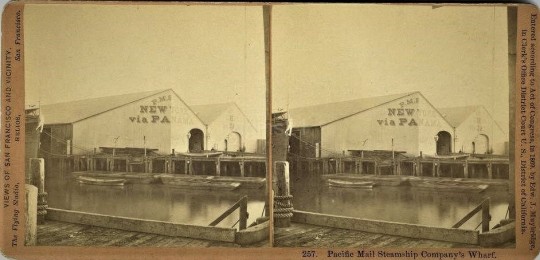
“257. Pacific Mail Steamship Company’s Wharf” c. 1869 -1871. Photo and stereoview by Eadweard J. Muybridge (from a private collection). The Pacific Mail’s wharf at the foot of Brannan Street in San Francisco at the approximate location of its old Pier 36. This was the first waterside view of the city for virtually every Chinese immigrant making landfall in San Francisco.
For the first six decades of the Chinese diaspora to the US, the sheds provided the first experience for every Chinese immigrant on California soil.
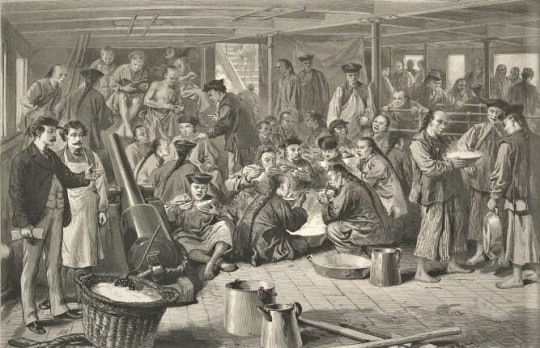
“Chinese Emigration to America,” no date. Illustrator unknown (from the collection of the Bancroft Library). This illustration shows life aboard a Pacific Mail Steamship Co. ship making the passage from China to San Francisco.
Amidst the Gold Rush and burgeoning industries like mining, agriculture, and construction, Chinese immigrants from southern China flocked to California. The PMSSC’s sheds, located along San Francisco’s waterfront, played a crucial role in handling cargo, passengers, and immigrants who arrived via steamships. Serving as pivotal infrastructure, they provided storage space for goods, customs processing areas, and waiting areas for passengers.
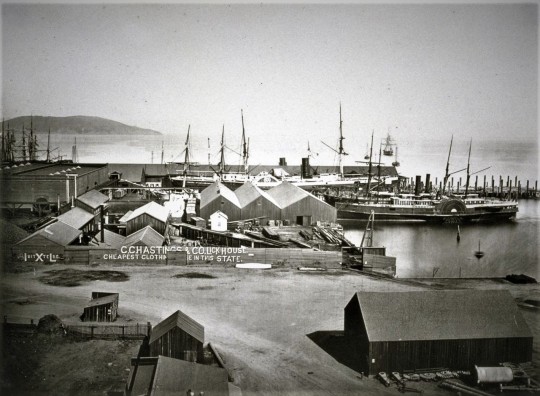
Pacific Mail Steamship Co. dock, c. 1864- 1872. Photograph by Carlton Watkins, probably derived from Watkins Mammoth Plate CEW 611. (from a private collection, the Roy D. Graves Pictorial Collection, Bancroft Library; and the San Francisco National Maritime Museum). In this elevated view east from Rincon Hill to the Pacific Mail dock, sidewheel steamer vessels identified by the SF National Maritime Museum as the SS Colorado (built in 1865 and scrapped in 1879), the steamer SS Senator at right (1865-1882), and various sailing ships are seen with Yerba Buena Island in the background. The Oriental Warehouse (built 1867 and still standing at 650 Delancey Street) is at left. The opensfhistory.org site identifies the three-part wooden structure at center as the Occidental Warehouse, used for grain storage, with blacksmith and boiler shops to the left. Ads for C.C. Hastings & Co. Clothing at Lick House can be seen on the fence.
Even as the Gold Rush waned, the PMSSC initiated in 1867 the first regularly scheduled trans-Pacific steamship service, connecting San Francisco with Hong Kong, Yokohama, and later, Shanghai. This route facilitated an influx of Japanese and Chinese immigrants, enriching California’s cultural diversity.
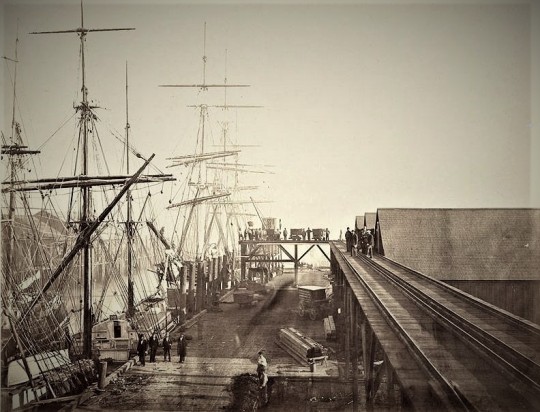
Pacific Mail Steamship Co. docks, c. 1871. Photograph by Carleton Watkins (from a private collection).
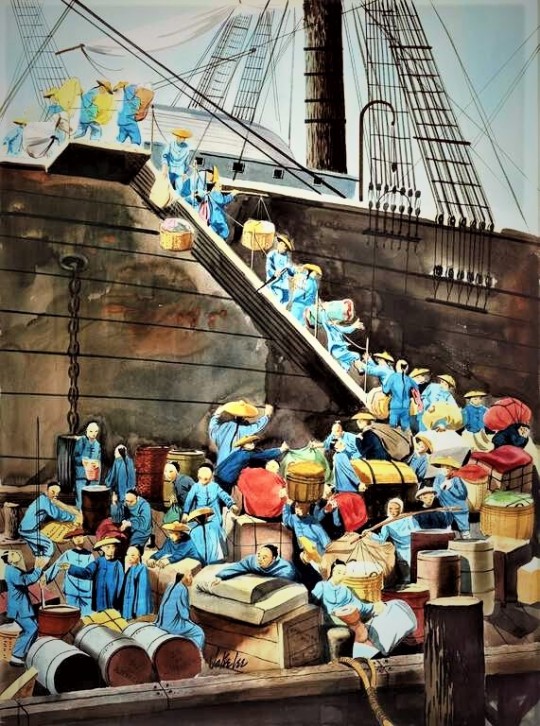
“Disembarking.” Painting by Jake Lee (from the collection of the Chinese Historical Society of America). In this watercolor, one among a suite of paintings commissioned by Johnny Kan for his then-new Kan’s Restaurant on San Francisco’s Grant Avenue in Chinatown, artist Jake Lee depicted a stylized unloading of mostly male passengers at the Pacific Mail Steamship Co. wharf in San Francisco.
When a ship dropped anchor at the dock in San Francisco, the emigrants finally set foot on American soil. A journalist for the Atlantic Monthly in 1869 described the debarkation of 1,272 Chinese as follows:
"… a living stream of the blue coated men of Asia, bearing long bamboo poles across their shoulders, from which depend packages of bedding, marring, clothing, and things of which we know neither the names nor the uses, pours down the plank…. They appear to be of an average age of twenty-five years… and though somewhat less in stature than Caucasians, healthy, active and able bodied to a man. As they come down upon the wharf, they separate into messes or gangs of ten, twenty, or thirty each, being recognized through some to us incomprehensible free-masonry system of signs by the agents of the Six Companies as they come, are assigned places on the long broad shedded wharf [to await inspection by the customs officers]."
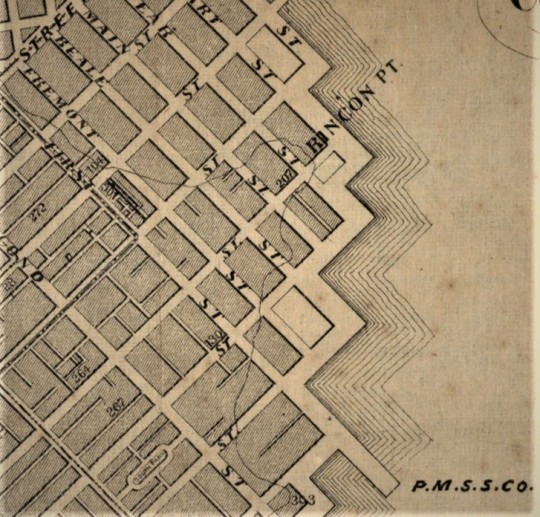
A detail from the "Bancroft's Official Guide Map of San Francisco" of 1873. The lower right corner of the image locates the Pacific Mail Steamship Co. pier at the foot of First Street (at Townsend) running in a southeasterly direction. According to local historian Garold Haynes, "that was before the seawall realignment of the waterfront in the late 1870s."
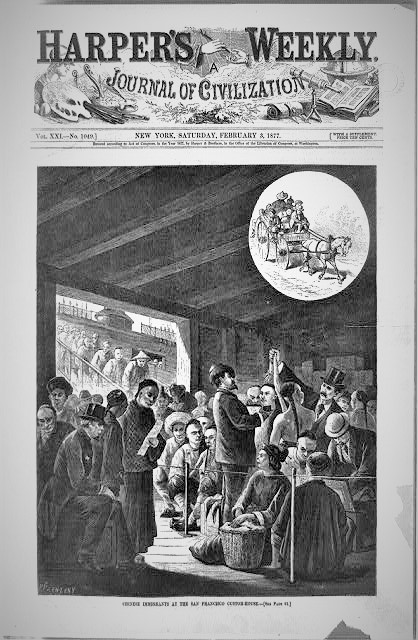
“Chinese Immigrants by The San Francisco Custom House” Harper’s Weekly, February 1877. Illustration by artist Paul Frenzeny (from the collection of the Library of Congress). Chinese immigrants wait for processing in the Pacific Mail Steamship Co.’s sheds while more arrivals from China disembark from the gangway seen in the background.
For many of the immigrants arriving on Pacific Mail steamships, the sheds served as the initial point of contact with the United States. Additionally, the sheds served as immigration processing areas, where Chinese immigrants underwent inspections and screenings. The sheds were a crowded and unsanitary place. Immigrants were often forced to wait for days in the sheds before they could be processed. They were also subjected to medical examinations and interrogations by immigration officials.
As the Atlantic Monthly writer described in 1869 described after each group passed through customs, “. . .They are turned out of the gates and hurried away toward the Chinese quarters of the city hv the agents of the Six Companies. Some go in wagons, more on foot, and the streets leading up that way arc lined with them, running in 'Indian file' and carrying their luggage suspended from the ends of the bamboo poles slung across their shoulders . . .”

In a political cartoon (c. 1888, based on the reference to the Republican Party presidential ticket of 1888 in the upper left corner of the image), Chinese immigrants stream off ships onto the wharves of the Pacific Mail Steamship Co. and the Canadian Pacific Steamship Co. and directly into the factories of San Francisco Chinatown and beyond. Illustrator unknown (from the collection of the Bancroft Library).
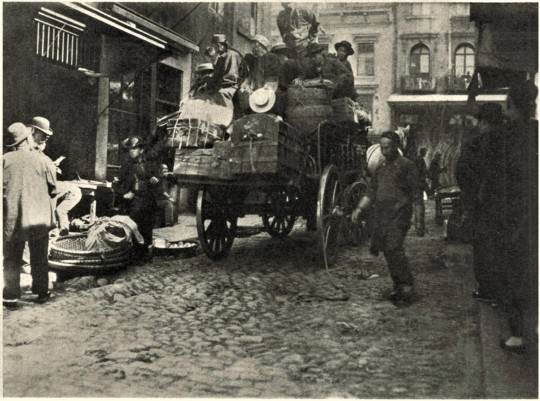
"New Arrivals." Date, location, and photographer unknown. The wagon on which the Chinese are riding, presumably having come directly from the Pacific Mail Steamship Co. wharf to San Francisco Chinatown, appears very similar to the 1877 configuration seen in the upper right corner of the preceding Harper's Weekly illustration.
The surge in Chinese immigration led to anti-Chinese sentiments, as reported in the illustrated magazines of the era. The arrival was often violent, as hoodlum elements would sometimes throw stones, potatoes and mud at the new immigrants. After the arrival in Chinatown, the newcomers were temporarily billeted in the dormitories of the Chinese district associations (citing Rev. Augustus W. Loomis, “The Chinese Six Companies,” Overland Monthly, os. v. 1 (1868), pp. 111-117).

“Hoodlums” Pelting Chinese Emigrants On Their Arrival At San Francisco” c. 1870s. Illustrator unknown (from a private collection). A rough sketch of the Pacific Mail Steamship Co. sheds appears in the background.
In San Francisco, local efforts to stop Chinese immigrants moved beyond the sheds and onto the arriving ships, which often became the focal points for Chinese litigants in the local and federal courts.
For example, in August of 1874, the Pacific Mail Steamship Company’s vessel Japan arrived in San Francisco carrying around 90 Chinese women. The Commissioner of Immigration boarded the ship and conducted interviews with about 50 to 60 of these women. From his inquiries, he concluded that 22 of them had been brought to San Francisco for “immoral purposes,” as reported by the Daily Alta California on August 6, 1874. When the Pacific Mail Steamship Company refused to provide the necessary bonds, the Commissioner instructed the ship’s master to keep the 22 women on board.
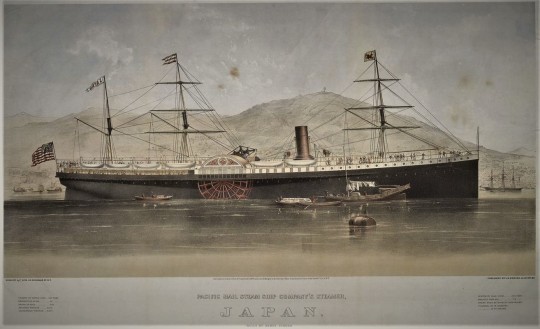
Pacific Mail Steam Ship Company’s Steamer, Japan, c. 1868. Print created by Endicott & Co. (New York, N.Y.), Menger, L. R., publisher (from the collection of The Huntington Library). Junks in the foreground, and, to the left in the background, Hong Kong’s Victoria Peak with semaphore at top appears in the background, center right. The SS Japan is flying the American flag from its stern, a Pacific Mail house-flag from the middle mast, and a pennant with the vessel’s name from the aft mast. A flag flying from the first mast appears to be a red dragon on a yellow field. Print includes vessel statistics and the name of the builder, Henry Steers.
Promptly, attorneys representing the detained women sought legal recourse by requesting a writ of habeas corpus from the state District Court in San Francisco. For two days, legal representatives from various parties engaged in debates over whether the Commissioner’s authority under the law was valid and whether the so-called “Chinese maidens” were indeed involved in prostitution. Reverend Mr. Gibson, who claimed expertise in this area, confidently asserted that Chinese prostitutes could be easily identified by their attire and behavior, likening the distinction to that between courtesans and respectable women in the city. He concluded that only half of the women were destined for prostitution. Ultimately, the District Court ruled that all the women should remain detained and ordered them to stay on the ship.
Shortly before the ship Japan was set to depart, the County Sheriff boarded and brought the 22 women ashore based on a writ of habeas corpus issued by the California Supreme Court. Two weeks later, Justice McKinstry, in a brief opinion on behalf of the court in Ex Parte Ah Fook, 49 Cal 402 (1874), affirmed the lower court’s decision, validating the Commissioner’s authority as a legitimate exercise of the state’s police power.

“258. Steamship Japan in California Dry Dock, Hunter’s Point, San Francisco”c. 1869. A side view of the steamship Japan of the Pacific Mail Steamship Company at the dry dock at Hunters Point. Photograph by Thomas Houseworth (from the Marilyn Blaisdell Collection). The ship would become the setting for a controversial habeas corpus case involving the entry of 22 Chinese women over the objections of state authorities in the case of Ex Parte Ah Fook, 49 Cal 402 (1874).
A third writ of habeas corpus presented the matter to the United States Circuit Court, presided over by Justice Stephen J. Field and Judge Ogden Hoffman. During the oral arguments, Justice Field made it clear that he wouldn’t dismiss constitutional arguments as easily as the state Supreme Court had, emphasizing the principle of equal treatment for citizens and non-citizens.
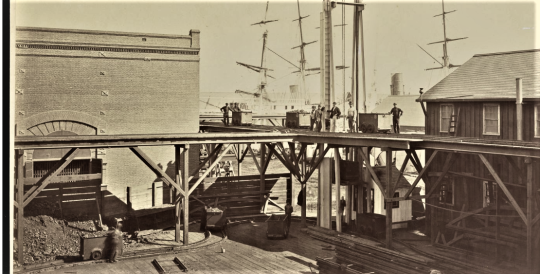
The Pacific Mail Steamship Co. derrick and coal yard in San Francisco, c. 1871. Photograph by Carleton Watkins (from the collection of the California Historical Society).
In the ruling, Justice Field discharged the petitioners, stating that California’s statute surpasses a state’s legitimate police power and violates the principle of “the right of self-defense.” He noted that the statute could exclude individuals who posed no immediate threat to the state. Judge Hoffman, in a concurring opinion, went further, suggesting that the states should have no control over immigration due to the exclusive nature of the commerce clause.
Although the Circuit Court decision released the Chinese women, while limiting the state’s power over Chinese entry, the Japan case reinvigorated California’s efforts to deter Chinese immigration. The influx of Chinese immigrants coupled with high unemployment in the late 1870s allowed Dennis Kearney of the Workingmen’s Party to target the Chinese as scapegoats. The “Chinese must go” movement gained traction, with both the Republican and Democratic parties adopting anti-Chinese stances.
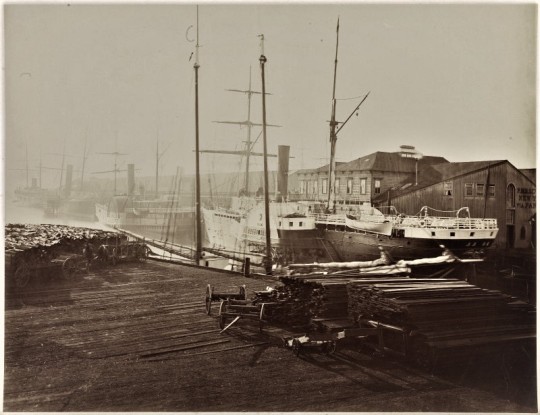
The Pacific Mail Steamship Co.’s wharf in San Francisco. Photograph by Carleton Watkins (from the collection of the Fine Arts Museums of San Francisco).
During the San Francisco Riot of 1877, the sandlot mob attacked the wharves of the Pacific Mail Steamship Company, because this shipping line represented the primary mode of transportation for America-bound Chinese immigrants headed to California. Although the steamships were not burned, the wharves were partially wrecked. Rioters also burned the lumber and hay yards adjacent to the Pacific Mail wharves.
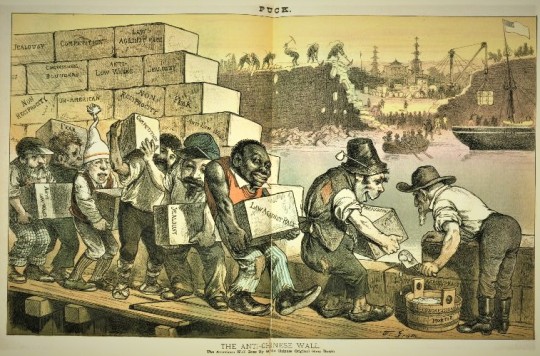
“The Anti-Chinese Wall – The American Wall Goes Up as the Chinese Original Goes Down.” Illustration by Friedrich Graetz in Puck of March 29, 1883 (v. 11, no. 264). The cartoon portrays a multi-ethnic coalition gathered on the wharf to halt Chinese immigration in the aftermath of the passage of the Chinese Exclusion Act in May 1882.
California was able to transfer its racial grievances and resentments to the national stage, culminating in the passage of the Chinese Exclusion Act in 1882. This marked a turning point in the history of Chinese immigration and had profound effects on the Chinese-American community. The Act severely restricted Chinese immigration to the United States.
The use the PMSSC’s sheds posed significant challenges to federal and state attempts to enforce the Exclusion Act (and its punitive extension in the Geary Act of 1892), against all Chinese, regardless of birth or immigration status.
As an article in the San Francisco Call of May 12, 1900, details, the chaotic scene at the Pacific Mall dock where Chinese immigrants disembarked from the ship Coptic was typical for that era. In the Coptic case, federal officials were observed allowing the landing of alleged "coolies" despite the spirit of the exclusion act, causing outrage. The detention shed, initially meant for temporary housing, had become a long-term residence for over 370 Chinese immigrants, generating substantial profit for the PMSSC. The maintenance of this facility posed several concerns, including violations of health regulations and potential disease outbreaks. The Call decried the authorities' negligence in enforcing the law and highlighted the role of a Chinese "ring" in facilitating fraudulent practices and illegal immigration. With multiple ships arriving with more immigrants, the newspaper called for investigation and reform.

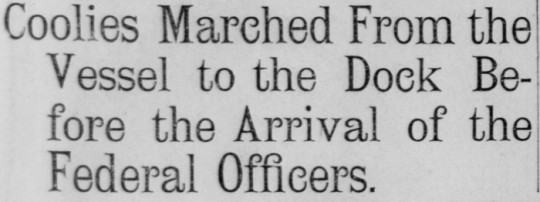


Headlines from the The Call of May 12, 1900, regarding the crowd of detained Chinese immigrants disembarked from the Pacific Mail ships Coptic and America Maru, the lack of security in the Pacific Mail sheds, and alleged immigration fraud.

Illustrations and photographs from the San Francisco Call of May 12, 1900, for its report about the crowd of detained Chinese immigrants disembarked from the Pacific Mail ships Coptic and America Maru, the lack of security in the Pacific Mail sheds, and alleged immigration fraud.
For Chinese and other immigrants and travelers from Asia, the transpacific journey, and even entering San Francisco Bay itself, posed hazards. The dangers were never more evident than in the case of the SS City of Rio de Janeiro. Launched in 1878, this steamship had been an essential component of the Pacific Mail Steamship Company's fleet. Its routes connected pivotal locations such as San Francisco, Honolulu, Yokohama, Japan, and Hong Kong, and the ship had played a role in America's expansion into the Far East and the Pacific in the aftermath of the Civil War and during the Spanish American War.

“A Thousand Boys in Blue S.S. Rio de Janeiro bound for Manila” copyright 1898. Published by M.H. Zahner (from the collection of the Robert Schwemmer Maritime Library). Built by John Roach & Son in 1878 at Chester, Pennsylvania, this vessel had served as a vital link between Asia and San Francisco, regularly transporting passengers and cargo. This stereograph shows its charter by the federal government for use as a military troop transport during the Spanish American War.
On the morning of February 22, 1901, the SS City of Rio de Janeiro commenced its approach to the Golden Gate and the entrance to San Francisco Bay. They had sailed with a crew that was mostly Chinese. History indicates that approximately 201 people were aboard the Rio de Janeiro, as follows: Cabin passengers 29; second cabin, 7; steerage (Chinese and Japanese), 68; white officers, 30; Chinese crewmen, 77. Of the Chinese crewmen, only two spoke English and Chinese. During the long voyage, the ship’s officer gave orders by using signs and signals. The ship’s equipment and lifeboat launching apparatus appeared to be in good working order and were capable of being lowered in less than five minutes.
Near the location of the future location of the Golden Gate Bridge, tragedy struck as the SS City of Rio de Janeiro. In the dense morning fog that obscured the surroundings, the ship collided with jagged rocks on the southern side of the strait, near Fort Point. The vessel’s non-watertight bulkheads led to rapid and unstoppable flooding. In a mere ten minutes, the SS City of Rio de Janeiro succumbed to the relentless forces of the sea.
The majority of the passengers, many of whom were Chinese and Japanese emigrants in steerage, were caught unaware in their cabins as the ship sank. The toll was staggering, with 128 lives lost out of the 210 souls on board. Of the 98 Asians reportedly on board the ill-fated ship, only 15 passengers were rescued, and 41 Chinese crewmen survived.
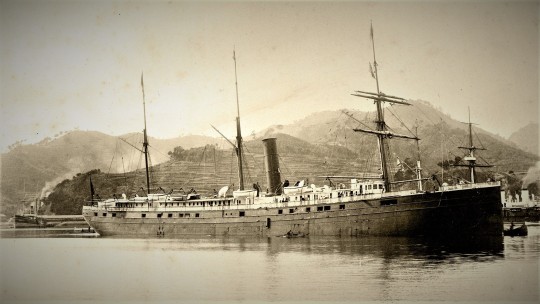
The SS City of Rio de Janeiro in Nagasaki, Japan, c. 1894. Photographer unknown (from the collection of the San Francisco Maritime National Historical Park). The ill-fated ship, which transported passengers and cargo between Asia and San Francisco, sank seven years later after running into rocks near the present site of the Golden Gate Bridge. The never-salvaged shipwreck rests 287 feet underwater.
The sinking of the SS City of Rio de Janeiro represented the deadliest maritime disaster at the San Francisco Bay's entrance, forever etching its name in the annals of maritime history as the “Titanic of the Golden Gate,” drawing a sad parallel to another infamous shipwreck. Today, the case serves as a reminder of the unpredictable forces of nature and the inherent dangers of maritime travel to which thousands of Chinese immigrants and other Asian travelers subjected themselves to gain a better life in America.
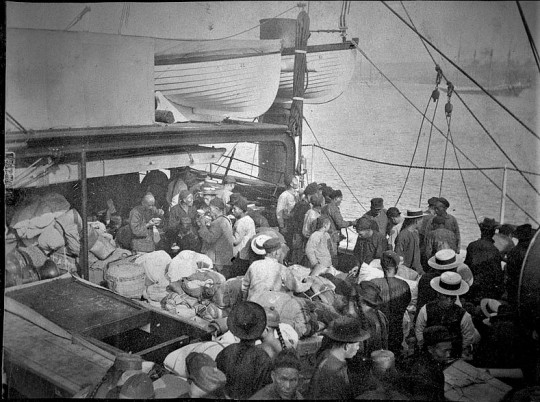
"Chinese Passengers on Deck, 1900–15," enroute to Hawaii. Photographer unknown (from the collection of the Hawaii State Archives). Chinese passengers, some eating from rice bowls, crowd the deck of a steamship. After the Exclusion Acts, the numbers of Chinese voyaging to the US had decreased sharply.
Despite reduced immigration due to the passage of successive exclusion acts in 1882 and 1892, the PMSSC's sheds remained operational, their purpose shifting from off-loading immigrants to facilitating trade and commerce between the east and west coasts of the US.

The Pacific Mail Steamship shed on the San Francisco waterfront at the turn of the century. Photograph attributed to Arnold Genthe. Located at the former pier 36, where Brannan Street runs into the Embarcadero, the immigration station was moved to Angel Island in 1910. Pier 36, the last of the docks at Brannan was torn down in 2012. In just one year, 1852, 25,000 Chinese entered California for the Gold Rush and other opportunities. Chinese America began here.
The convergence of the Central Pacific and Union Pacific railroads in Utah in 1869, had started the process of eroding the Pacific Mail's profitability on the Panama-to-San Francisco route over the ensuing decades, eventually leading to the sale or redirection of many of its ships to other routes.

The Pacific Mail Steamship Co. offices on the southeast corner of Market and First streets in downtown San Francisco, c. 1896. Photographer unknown (from a private collection).
The landscape changed drastically in 1906, when a devastating earthquake and subsequent fire struck San Francisco, including the PMSSC’s wharf facilities. Although destroyed during 1906 disaster, the PMSSC’s sheds were rebuilt shortly thereafter. The sheds continued to be used for detaining and interrogating Chinese immigrants until the opening of immigration station facilities on Angel Island in 1910 for the processing Chinese and other immigrants.
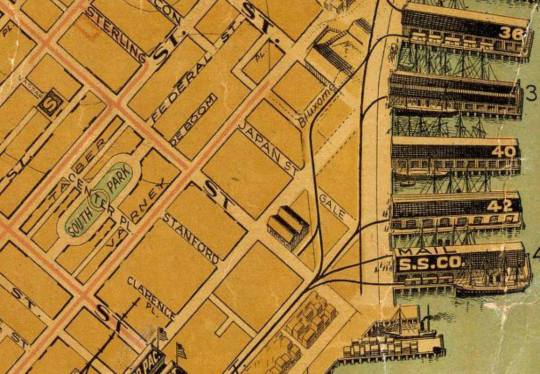
A detail from the August Chevalier Map of 1915. The PMSSC sheds were located on Pier 36 at the intersection of Brannan and First Street.
The legacy of the PMSSC’s sheds, intertwined with their role at the inception of Chinese immigration to California and the US, is deeply rooted in San Francisco's maritime and Chinese American history. Both the company's operations and the experiences of the first wave of the Chinese diaspora arriving on American shores by steamships will remain forever part of the socio-economic dynamics of 19th-century San Francisco and the American West.

“Chinese Immigrants by the San Francisco Custom House” c. 1877. Detail of the magazine cover illustration by artist Paul Frenzeny for the Harper’s Weekly (from the collection of the New York Public Library.
[updated 2023-10-17]
#Pacific Mail Steamship Co.#Pacific Mail sheds#Chinese immigration detention#Carleton Wtakins#Paul Frenzeny#Harper's Weekly#SS Japan#In re Ah Fook#Stephen Field#Eadweard Muybridge#Pier 36 San Francisco
6 notes
·
View notes
Text
Victoria's Pride: Regional Pride events across Victoria
New Post has been published on https://qnews.com.au/victorias-pride-regional-pride-events-across-victoria/
Victoria's Pride: Regional Pride events across Victoria

To ensure statewide representation of LGBTQIA+ arts and cultures. Victoria’s Pride has commissioned community groups, organisations and artists in regional Victoria to facilitate events and celebrations to coincide with Melbourne’s Midsumma Festival.
With events across regional Victoria, there is bound to be something for all LGBTQIA+ Victorians.
Gippsland
Gippsland Pride Festival
Think ‘Summer Carnival’ with stalls and resources, music, food and connection with community.
Gippsland Pride have partnered with local outdoor pools and community facilities to host a day of celebration, connection and fun for families and folks of all ages.
3 February – Trafalgar Outdoor Pool, 10am – 2pm 10 February – Yallourn North Outdoor Pool, 10:30am – 2:30pm
Registration is required for free entry via Humanitix, or gold coin donation requested on the day
IN OTHER NEWS: Karen From Finance to bring a dozen drag stars to Mardi Gras
Wangaratta
Pride Fair Day
LGBTQIA+ In the North East (LINE) Wangaratta, supported and partnered with a variety of local organisations, will coordinate a Pride Fair Day on Friday 9th February 2024, celebrating and embracing LGBTQIA+ culture, music, art and performance in a safe and inclusive space.
WHEN: 9 February 2023 3pm WHERE: Batchelors Green, Tone Rd, Wangaratta TICKETS: FREE ACCESSIBILITY: Wheelchair accessible – There are some physical access limits due to venue
Bendigo
The Big Book of Queer Bendigo – A Victoria’s Pride Celebration
The Big Book Of Queer Bendigo is a full-colour coffee table book exploring and celebrating the LGBTQIA+ history of Bendigo and the goldfields region. So much of queer history is hidden, unrecorded or presented as tragedy. Not this time!
The Big Book Of Queer Bendigo isn’t a dry textbook but a fabulous scrapbook of fantastic lives and exceptional living. Including:
Our oral history project, exploring local life in the 1960s, 70s and 80s;
Pieces about great historical Bendigo characters including 1880s transman and global sensation Edward de Lacy Evans, and Bendigo artist Agnes Goodsir and her lesbian circles in 1920s Paris;
Queer organisations including the Bendigo Queer Film Festival, Queer Country Art Exhibition, Trans And Gender Diverse Bendigo & Beyond and the Trans Clothing Swap;
and voices of local LGBTQIA+ writers, artists, photographers exploring what it means to be queer in regional Victoria – growing up, moving back or just staying still.
The Big Book of Queer Bendigo will officially launch at the Victoria’s Pride Street Party in Fitzroy.
WHEN: 9 February 2024 | 11 February 2024 WHERE: Bendigo | Victoria’s Pride, Fitzroy TICKETS: Book will be available for $50 ACCESSIBILITY: Wheelchair accessible
Sunbury
Sounds Gay, I’m In! Picnic
A beautiful summer picnic to provide a unique intergenerational opportunity for First Nations LGBTIQA+ community, non-indigenous LGBTIQA+ community and allies to come together and celebrate intersectional Pride.
WHEN: 10 February 2024, 2:00pm – 5:00pm WHERE: The Old Sunbury Courthouse, 43 Macedon Street Sunbury TICKETS: FREE event – register to attend here ACCESSIBILITY: Wheelchair accessible & Auslan Interpreted
Wonthaggi
Bass Coast Youth Pride Prom
The Bass Coast Youth Pride Prom is a celebration event for LGBTQIA+ young people and their allies, aged 12 – 25. An event designed by young people, for young people, every aspect of the celebration is determined by the Pride Tribe – from location, food, entertainment, music, and more!
WHEN: 10 February 2024, 6:30pm – 9:30pm WHERE: Wonthaggi Town Hall, Wonthaggi TICKETS: FREE event – Bookings essential via Eventbrite ACCESSIBILITY: Wheelchair accessible
Kyneton
Queerthentic – Regional LGBTQIA+ Art Prize
Queerthenic reveals authentic stories from Central Victorian LGBTQIA+ and gender-diverse artists in this regional art prize. These stories delve into the mundane everyday, fabulous culture, or explore the influence of queer history and culture on their past, present, and future lives.
WHEN: 25 January – 12 February 2024 | Celebration & Winner Announcement 3 February 2024 WHERE: The Old Auction House, Kyneton
Additional information is available online.
For the latest LGBTIQA+ Sister Girl and Brother Boy news, entertainment, community stories in Australia, visit qnews.com.au. Check out our latest magazines or find us on Facebook, Twitter, Instagram and YouTube.
0 notes
Text
Tonopah and Tidewater Railroad
Explorers of the Mojave Desert in southern California are bound to have heard the stories of the Tonopah and Tidewater Railroad. The Tonopah and Tidewater flanks the western edge of the Mohave National Preserve as travels south to north from Ludlow, California to Beatty, Nevada and up to Tonopah, Nevada utilizing the Bullfrog Goldfield Railroad. Many of the off ramps, sites and historic monuments…

View On WordPress
#Atchison Topeka & Santa Fe Railroad#California#Las Vegas & Tonopah Railroad#Los Angeles & Salt Lake Railroad#Nevada#Nye County#San Bernardino#Santa Fe Railway#Tonapah & Tidewater Railroad
0 notes
Text
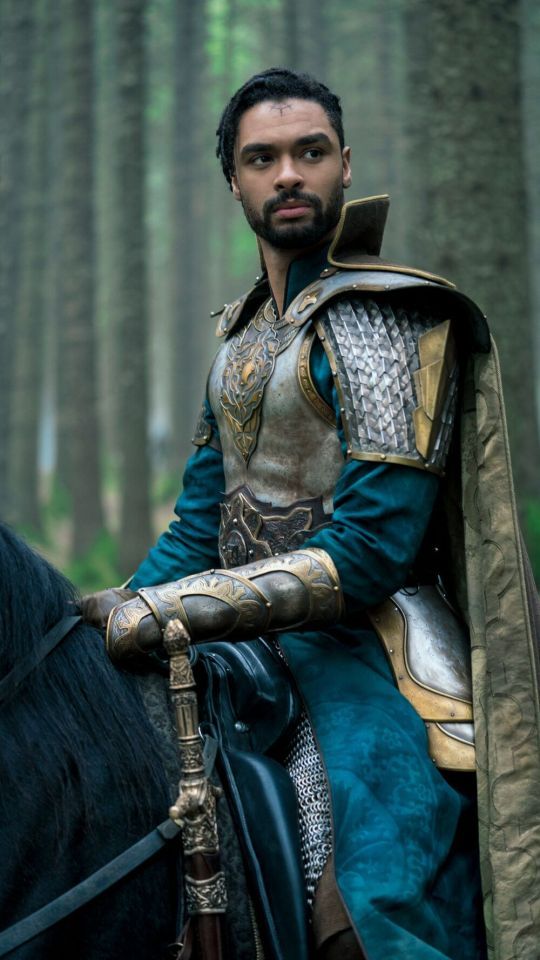
Holding Out for a Hero: Part 3
I agree with the comment, the last part got very serious. I have time, here is a little Easter gift for anyone who has liked the story thus far. I've started rolling a die for characters making checks (you'll see later) and using that for writing.
This section is more about Alariel and Xenk's past, do enjoy less angst. Links to earlier parts under the cut.
Xenk X Cleric!OC
No Beta, we die like men.
______________________________________________________________
"If it makes you feel any better, both Edgin AND Doric chewed him out."
Alariel looked up to see the muscle-bound woman, Holga, standing at the entrance to her tent. It had been an hour or so since she had met the barbarian.
"I stand by what I said. I cannot travel with you, not with him. Besides, with him here you really don't need me."
"I didn't come here to ask you to help us again." Alariel looked up at her in confusion. Holga sat down beside her on the cot. "I wanted to make sure you were okay. I know how shitty it can be running into your ex."
"Oh." She didn't know what to say. Maybe it was because she was used to doing all of the looking after. Alariel hadn't had someone to look after her in quite some time.
"So should we be calling you Alariel or Lyra?" Holga offered her one of the rolled calligrapher's tool sets that had been set out to be placed into her bag of holding.
"Either is fine. One of the younger children had some difficulty pronouncing my name, and it sort of stuck with the people of the community. It was sweet." Her hands stilled in packing as she smoothed the leather cover of a journal.
"You don't have to leave since we showed up. Don't wanna chase you out of your home." Holga looked closer at the young woman. She appeared to be younger than her, but it was always hard to tell with elves. If this one knew Xenk, she was at least 100 years older than her.
"No, this just gives me a reason to finally move on. Like I had said, I lingered here too long anyway." She took a stack of her journals in hand and continued her packing.
"If you don't mind me asking, where will you go?"
"I've been heading to the Sword Coast for a while now. I haven't been in a city in some time, so perhaps I will make my next stop in Waterdeep before heading up to Neverwinter. I know I could spend the next century in either place and never hear the same story twice."
"It's funny you mention that..."
And that was how Alariel learned that the odd band of adventurers who were looking for her help were actually the heroes of Neverwinter. By the time Holga had finished telling her version of the story, Alariel had to set out her Orb of Light and had practically filled a scroll with the details.
"This still doesn't make sense..." Lyra's brow was furrowed. "You are still being chased by these assassins?"
"We lost them most recently around the Goldfields. I chopped one up real good and threw the parts in the river." Lyra was both disgusted and impressed at the barbarian's work.
"But why isn't Xenk just smiting them?"
"Doing what?"
"Smiting. You know, holy radiance on the blade... thundering force... banishing fiends?" Holga still gave her a blank stare.
"I mean, his sword-dagger glowed when he was fighting that assassin in the Underdark?" Alariel gave a small shake of her head. Why wasn't Xenk using his paladin abilities? A soft glow to his blade could be compelled duel, but she had seen firsthand the brilliance of his devotion. Why wouldn't he have killed them the first time? Destroying the undead was part of his mission.
"Anyway-" Alariel knew she couldn't get invested in this new mystery, no matter how much she wanted to, "I think I've kept you up late enough as is. Humans need more sleep than elves do, yes? Thank you again for letting me record your story."
"No problem. I was curious after seeing how many books you had in your tent. What the fuck is up with that?"
Lyra shook her head, and laughed at the crude language of her new friend. "No wonder you all are so confident in my abilities to defeat Thay assassins. I'm no war cleric, I am a follower of Deneir."
"The Scribe of Oghma?"
"The God of Glyphs and Images?"
Holga's eyes lit up with recognition. "The candle with the eyeball!"
Lyra deflated and looked at Holga confused and a bit concerned. "How in Oghma's name did you know that, but not his domains?"
"My ex-husband used to frequent this bookstore, and it had a little shrine in the window. I asked one day who it was for."
Not long after their discussion, Holga left to meet with the other members of her makeshift family. They had found a section of the shanty town where they were allowed to pitch a tent. While Simon, Kira, and Doric were trying to get the tent out of the opening in Simon's bag of holding, Edgin still was pacing back and forth in front of Xenk, who looked to be meditating on a bare patch of ground.
"A note!? You left her alone with a note-"
Xenk seemed to be ignoring him at this point, but Edgin had said the same speech about 9 times.
"-You were engaged! How does this not come up in conversation, I mean really you think you know a guy.-"
Holga walked up to the tent-pitching group. "Hey bug, think your old man will run out of steam any time soon?"
"I don't think so." Kira looked between the paladin and her father, "Not only did he royally embarrass himself, but with love you know he's always had this sense of self-righteous honor."
"Well I for one," Simon interrupted, "would love it if he would stop. Maybe then I could finally concentrate on getting these poles to stay up."
Doric rolled their eyes, "Sure like that's the issue."
Suddenly, Xenk turned toward the outside of the village. Standing, he drew in a deep breath. Glancing around, he drew his sword,
"They have found us."
#hofah hat 3#xenk x oc#xenk the paladin#xenk yendar#dnd hat#dnd movie#fanfiction#fanfic#my writing#no beta we die like men#my oc#cleric!oc#dnd#honor among thieves#light angst
26 notes
·
View notes
Note
Thank you for the link!! Also realised that I wasn’t polite in my last ask like no hello or please or thank you smh I’m working on amelerioting my tone of entitlement. I’ve been reading a lot on afro pessimism and it validated a lot of my thoughts on terms like ‘woc’ and equation of white supremacy to all groups so I decided to write my diss on global anti black discourse and thought I’d ask for your opinion bc I admire your thoughts on here! Anyway, thank u Najia, have a nice day !!
don’t worry about it 💖💖
one thing to consider w this (& forgive me if I’m repeating things you already know) is the difference some ppl draw between ‘antiblackness’ & ‘anti-black racism’ where anti-black racism is a set of ideas, stereotypes, &c. that has a corollary in other forms of racism and racial prejudice e.g. anti-Asian racism. whereas antiblackness is a more specific set of ideas about what it means to be human & to participate in human history, &c. that rely on ‘blackness’ specifically to underpin ideas of racial difference.
the pitfall here imo is to fail to articulate or define just what it is that you mean by ‘blackness’ & thus fail to historicise antiblackness adequately. some takes assume that it’s transhistorical & transcultural (or at least push the problem of origins further back without any gesture towards historical specificity) which is certainly a racialist (i.e. believing in the natural existence of ‘races’) take, if not a racist one. so the problem is to connect that discourse or rhetoric to its particular socioeconomic milieu & what it’s being used to justify, what earlier modes of aesthetic judgement or prejudice it might incorporate & alter to its own purposes and where it got them from, without applying the lens of hindsight or believing that these must all be manifestations of the exact same thing (you might decide that they are! but what I mean is that you have to justify that in how you define your terms)
you can tell that what I’m working on rn is in a U.S. frame, lmfao, but these present a couple of different perspectives:
Allen,Theodore. ‘“…They Would Have Destroyed Me”: Slavery and the Origins of Racism’.Radical America, vol. 9, 1975, pp.41-63.
–, The Invention of the White Race. Verso, 1997.
Fields,Barbara. ‘Slavery, Race and Ideology in the United States of America’. New Left Review, vol. 181, 1990, pp.95–118.
Goldfield,Michael. ‘The Color of Politics in the United States: White Supremacy as theMain Explanation for the Pecularities of American Politics from Colonial Timesto the Present’ in The Bounds of Race: Perspectives on Hegemony and Resistance, ed. Dominick LaCapra. CornellUniversity Press, 1991, pp. 105-133.
Harvey, Sean P. ‘Ideas of Race in Early America’. Oxford Research Encyclopedia of American History, 2016.
Lowe, Lisa. The Intimacies of Four Continents. Duke University Press, 2015.
Sweet, James H. ‘The Iberian Roots of American Racist Thought’. The William and Mary Quarterly, vol. 54, no. 1, 1997, pp. 143–166.
Vaughan, Alden T. ‘The Origins Debate: Slavery and Racism in Seventeenth-Century Virginia’. The Virginia Magazine of History and Biography, Vol. 97, No. 3, 1989, pp. 311-354.
plus some of the other readings in this post
65 notes
·
View notes
Video
Five Car Cruise by Joshua_Watson Via Flickr: K153, again sporting the "VGR" headboard, hauls a five car train up the Mckenzie Hill gradient bound for Maldon. This trip to Maldon was part of a five-day rail adventure from Sydney down to Melbourne, featuring four different steam locomotives and five diesel locomotives. During this leg of their action packed five days, the passengers were greeted by A² 986, which had hauled the passengers from Southern Cross to Castlemaine. They then had the chance to visit Maldon and return by steam, for a day on the goldfields railway. Later on in the evening, the Cruise Express passengers headed back to Melbourne again behind A² 986, ready for their day ahead. Mckenzie Hill, Vic. 1/9/18
2 notes
·
View notes
Text
St Patrick's Cathedral, Melbourne
St Patrick's Cathedral, Melbourne
Church in Melbourne, Australia
For other uses, see St. Patrick's Cathedral (disambiguation).
The Cathedral Church and Minor Basilica of Saint Patrick (colloquially St Patrick's Cathedral) is the cathedral church of the Roman Catholic Archdiocese of Melbourne in Victoria, Australia, and seat of its archbishop, currently Peter Comensoli.
Quick Facts Location, Denomination ...
In 1974 Pope Paul VI conferred the title and dignity of minor basilica on it. In 1986 Pope John Paul II visited the cathedral and addressed clergy during his Papal Visit.
The cathedral is built on a traditional east–west axis, with the altar at the eastern end, symbolising belief in the resurrection of Christ. The plan is in the style of a Latin cross, consisting of a nave with side aisles, transepts with side aisles, a sanctuary with seven chapels, and sacristies. Although its 103.6-metre (340 ft) length is marginally shorter than that of St Mary's Cathedral, Sydney, St Patrick's has the distinction of being both the tallest and, overall, the largest church building in Australia.
Location
The cathedral is located on Eastern Hill in Melbourne, in an area bounded by Albert Street, Gisborne Street, Lansdowne Street and Cathedral Place. Just to the west across Gisborne Street is St Peter's Church, constructed from 1846 to 1848, which is the Anglican parish church of Melbourne.
History
In 1848, the Augustinian friar James Goold was appointed the first bishop of Melbourne and became the fourth bishop in Australia, after Sydney, Hobart and Adelaide. Negotiations with the colonial government for the grant of five acres of land for a church in the Eastern Hill area began in 1848. On 1 April 1851, only 16 years after the foundation of Melbourne, the Colonial Secretary of Victoria finally granted the site to the Roman Catholic Church.
Goold decided to build his cathedral on the Eastern Hill site.
Since the Catholic community of Melbourne was at the time almost entirely Irish, the cathedral was dedicated to St Patrick, the patron saint of Ireland.

View of the main entrance to the cathedral
William Wardell, Melbourne's foremost ecclesiastical architect was commissioned to prepare plans for a cathedral, but the project was delayed by severe labour shortages during the Gold Rush of 1851, which drew almost every able-bodied man in the colony to the goldfields, and the foundation stone was not laid until 1858. An earlier building by stonemason David Mitchell (father of Nellie Melba and later partner of John Monash) was demolished for the cathedral. The cathedral was designed in the Gothic style of late Thirteenth Century, based on the great medieval cathedrals of England, in response to the revival of Gothic architecture as promoted by Augustus Welby Pugin and others as the most appropriate for the building of churches. The style is specifically Geometric Decorated Gothic, showing this style at its most complex in the large west window of the nave. The eastern arm with its chevet of radiating chapels in the French manner is still principally in the English late Thirteenth Century style, giving the most complete essay attempted in that style during the Nineteenth Century. William Wardell was a remarkably ambitious and capable architect; he went on to design the second St Mary's Cathedral, Sydney in a similar style, even larger than St Patrick's, but with a completely English square East End.
St Patrick's Cathedral, Melbourne. The statue in the foreground is of the Irish nationalist leader Daniel O'Connell
In 1974 Pope Paul VI conferred the title and dignity of minor basilica on it. In 1986 Pope John Paul II visited the cathedral and addressed clergy during his Papal Visit. The building also saw a green ban in the 1970s.
Construction
In 1858 William Wardell was commissioned to plan the cathedral with a contract signed on 8 December 1858 and building commencing the same year.
St Patrick's Cathedral with scaffolding and St Patrick's School, Eastern Hill c. 1866 State Library Victoria H2119
Although the nave was completed within 10 years, construction proceeded slowly, and was further delayed by the severe depression which hit Melbourne in 1891. Under the leadership of Archbishop Thomas Carr the cathedral was consecrated in 1897 and even then it was not finished. Given the size of the Catholic community at the time, the massive bluestone Gothic cathedral was an immense and very expensive undertaking, and there were long delays while funds were raised. St Patrick's was one of the two largest churches brought to substantial completion anywhere in the world in the 19th century. The other is St Patrick's Cathedral, New York, United States.
Daniel Mannix, who became Archbishop of Melbourne in 1917, maintained a constant interest in the cathedral, which he was determined to see finished after the long delays during the previous 30 years. He oversaw the addition of the spires and other elements in the late 1930s. The building was officially completed in 1939.
The cathedral is 103.6 metres (340 ft) long on its long axis, 56.4 metres (185 ft) wide across the transepts and 25.3 metres (83 ft) wide across the nave. The nave and transepts are 28.9 metres (95 ft) high. The central spire is 105 metres (344 ft) high and the flanking towers and spires are 61.9 metres (203 ft) high. The bluestone used in its construction was sourced from basalt deposits in nearby Footscray.
Restoration
To celebrate the centenary of its consecration in 1997, the cathedral was closed throughout 1994 to be upgraded. Nothing was added to the main building. Rather, it underwent significant conservation work, with funds contributed by the federal and Victorian governments, corporate and philanthropic donors and the community of Melbourne.
The cathedral's stained glass windows had buckled and cracked and required a full year to restore to their original state. Teams of stonemasons and stained-glass craftsmen used "lime mortars and materials long-forgotten by the building trade — like medieval times". The 1992-97 restoration works were undertaken under the guidance of Falkinger Andronas Architects and Heritage Consultants. The works were awarded the Royal Australian Institute of Architects (Victorian Chapter) John George Knight Award for Heritage Architecture 1996. One of the gargoyles restored by the masonry team was modelled on the then-Premier of Victoria, Jeff Kennett.
Music
Cathedral choir
There has been music at St Patrick's since 1858, but the present cathedral choir was founded in 1939 when the Vienna Mozart Boys Choir found itself stranded in Australia at the outbreak of war. The National Museum of Australia holds a collection of the choir's memorabilia from this period. St Patrick's choir has between 50-60 members who are all students of St Kevin's College in Toorak, through a scholarship program from the archdiocese. The choir has made commercial recordings in the past, mainly from the 1950s to 1990s. Selected recording before the 1980s have been deposited with the National Film and Sound Archive (Screensound Australia).
Cathedral singers
Formed in May 1996, the St Patrick's Cathedral Singers supplement the musical resources of the cathedral. They sing weekly at the Sunday evening Mass. Entrance is by audition and some scholarship are available to eligible students from the Australian Catholic University.
Pipe organs
The cathedral's original pipe organ was built in the late 1870s by Robert Mackenzie and completed in 1880 by George Fincham. The current installation built by George Fincham & Sons, Melbourne in 1962-64 and incorporates a substantial part of the original. Installed in the west gallery of the cathedral, it comprises 81 speaking stops spread over four manuals and pedals. Some of the stops can be dated to 1880 or 1896, when the instrument was enlarged. The organ was refurbished in 1996-97 for the centenary of the cathedral. In addition to serving the liturgical needs of the cathedral, the organ is occasional used for recitals and recordings.
Great Organ C–1.Gemshorn16′2.Open Diapason8′3.Gemshorn8′4.Stopped Diapason8′5.Harmonic Flute8′6.Dulciana8′7.Principal4′8.Gemshorn4′9.Suabe Flute4′10.Twelfth22⁄3′11.Fifteenth2′12.Fourniture V13.Mixture V14.Grand Cymbel V15.Trumpet8′16.Clarion4′Swell C–17.Gedeckt16′18.Open Diapason8′19.Stopped Diapason8′20.Viola da Gamba8′21.Salicional8′22.Voix Céleste8′23.Principal4′24.Stopped Flute4′25.Twelfth22⁄3′26.Fifteenth2′27.Piccolo2′28.Cornet III29.Mixture V30.Double Trumpet16′31.Cornopean8′32.Trompette harm.8′33.Oboe8′34.Clarion4′Solo C–35.Harmonic Flute8′36.Viola8′37.Viola Céleste8′38.Concert Flute4′39.Flageolet2′40.Double Clarinet16′41.Clarinet8′42.Orchestral Oboe8′43.Cor Anglais8′44.Posaune8′45.Clarion4′46.Tuba8′47.Trompette en cham.8′Positiv Organ C–48.Principal8′49.Gedeckt8′50.Principal4′51.Quintadena4′52.Nazard22⁄3′53.Waldflöte2′54.Tièrce13⁄5′55.Larigot11⁄3′56.Sifflöte1′57.Zymbel IV58.Cromorne8′Pedals C–59.Acoustic Bass32′60.Open Diapason-Wood16′61.Gemshorn16′62.Violone16′63.Bourdon16′64.Gedeckt16′(continued)65.Octave -Wood8′66.Principal8′67.Bass Flute8′68.Gemshorn8′69.Violoncello8′70.Twelfth51⁄3′(continued)71.Fifteenth4′72.Flute Dolce4′73.Mixture IV74.Contra Bombarde32′75.Bombarde16′76.Double Trumpet16′(continued)77.Double Clarinet16′78.Bombarde8′79.Trumpet8′80.Clarion4′81.Trumpet4′
Bells
The bells of the cathedral were acquired by Bishop Goold, Melbourne's Roman Catholic leader at the time, when he visited Europe in 1851–1852. He bought a peal of eight bells for £500 (with some records showing that it cost £700). They arrived in Australia in 1853. The peal of eight bells is in F natural, with the tenor weighing 12 long cwt 1 qr 10 lb (1,382 lb or 627 kg) and the treble 4 long cwt 12 qr 14 lb (798 lb or 362 kg). The peal set weights around 3,556 kilograms (7,840 lb). The bells were all cast by John Murphy of Dublin in 1852.
The bells were hung in a low frame at ground level in the western aisle in 1868. The consecration service was attended by around 5,000 people. The eight bell bears the coat of arms of Bishop Goold. The bells were eventually hung at the south-eastern tower.
The ringers of St Patrick's began the custom of ringing in the New Year in 1871. And by the 1880s, St Patrick's Cathedral became the leading tower for Australian change ringing. The bells were rung for the requiem mass of Pope Pius X in 1914. By 1959 the belfry fell into disrepair and the bells became unringable. The bells remained silent until in 1988, when the peal was sent to Eayre and Smith Bell foundry in England as the major Victorian project among Bicententennial bell restorations. Upon their return, a ninth bell, an Angelus bell, was added. An electronic chiming mechanism was also installed at this time for all the bells. The original manual method was retained by the electronic mechanism, in order to replicate how the bells would have sounded if they were rung by hand. The entire eight headstocks had to be replaced just ten years after this installation. The ringers are affiliated with The Australian and New Zealand Association of Bellringers.
The bells are unusual in that they were cast untuned, they ring anti-clockwise instead of clockwise, and they are thought to be the only ring of eight bells cast by Murphy which are still in operation today.
Photo gallery
Gothic Revival architecture
East round court
Archbishop Daniel Mannix (1863-1964) bronze statue
Irish Nationalist leader Daniel O'Connell statue
St Catherine of Siena (1347-1380) statue
St Francis of Assisi (1181-1226) statue
River from the throne of God and of the Lamb
River Fall
Interior
Sanctuary
Interior
Organ
See also
List of cathedrals in Australia
Notes
References
External links
ABOUT THIS ARTICLE
View edit history
Updated 34 days ago
View talk page
Discuss improvements to this article
READ MORE
Rotherham Minster
Church in South Yorkshire, England
St Paul's Cathedral, Bendigo
Church in Bendigo, Australia
St James's Church, Kingston, Purbeck
Church in England
Content is available under CC BY-SA 3.0 unless otherwise noted.
View article in browser
0 notes
Text
Giants aim to end 2021 season with a hat-trick
Giants aim to end 2021 season with a hat-trick
Goldfields Giants coach Wayne Creek views the scalp of finals-bound Perth Redbacks today to complete the NBL1 West qualifying series as both a perfect finale and a fitting precursor.

View On WordPress
0 notes
Text
Tesla Powerpack Community Battery Bound For WA’s Kalgoorlie
Kalgoorlie-Boulder is to have the Goldfields region’s first community battery that will enable more rooftop solar power to be installed and provide other benefits. The 464 kilowatt-hour Tesla Powerpack battery system is to be integrated by Western Power into the local network, improving power quality and smoothing daytime and peak-time load periods. Starting in October, […]
The post Tesla Powerpack Community Battery Bound For WA’s Kalgoorlie appeared first on Solar Quotes Blog.
from Solar Energy https://www.solarquotes.com.au/blog/tesla-community-battery-wa-mb1534/
0 notes
Text
Tesla Powerpack Community Battery Bound For WA’s Kalgoorlie
Kalgoorlie-Boulder is to have the Goldfields region’s first community battery that will enable more rooftop solar power to be installed and provide other benefits. The 464 kilowatt-hour Tesla Powerpack battery system is to be integrated by Western Power into the local network, improving power quality and smoothing daytime and peak-time load periods. Starting in October, […]
The post Tesla Powerpack Community Battery Bound For WA’s Kalgoorlie appeared first on Solar Quotes Blog.
from Solar Quotes Blog https://ift.tt/2Xmr0O5 via IFTTT
0 notes
Text
On the 13th of September 2019, I convened a conference at the University of Bristol titled, ‘Decolonising the Law School.’ (The conference was sponsored by the Society of Legal Scholars as well as the Law School at the University of Bristol.) The purpose of the conference was to contribute to a process of accurate practice and theorisation of decolonisation which forces us to confront the history and effects of imperialism upon our academic practices (i.e. research and teaching) in law. This, I think is vital, because in a lot of the contemporary discourse on epistemic decolonisation, there is a focus only on decolonial practice and teaching, to the detriment of decolonial theory and research. Without decolonising research, I believe that we decolonise our teaching in vain.
I have written elsewhere, and much more extensively about my driving thoughts behind convening the conference. This is a process which for me continues to continue. Watch this space. In the meantime, below is the text and video of my welcome address at the conference. A programme of the event also follows.
In what has now become a tradition in many conferences across the globe, I would like to welcome you all into this space with a series of quite specific acknowledgements. I would like us to acknowledge the land where we stand. To acknowledge what this land means to the people who have lived on it, what it means to people who have passed through it, and what it means to people who have been affected by it though they are far removed from us in time and space. I would like us to recognise, remember and acknowledge the fact that Bristol is a city which is in many ways built on the trade in kidnapped African people. Stolen lives, stolen labour, stolen pasts, stolen futures and stolen possibilities. We should acknowledge the fact that this university is in many ways built on the back of that and that anywhere epistemicides preceded physical death, the academe as a whole is implicated. We should acknowledge that this building that we stand in was built from a legacy that cannot be disentangled from a history from which we have not divorced ourselves. Richard Stone, a historian here at this university discovered a saying about Bristol that dates back to the time of Queen Anne. The saying is: ‘There is not a brick in the city but what is cemented with the blood of a slave.’ And so, we must acknowledge the trauma that lives on in the atmosphere, we must acknowledge the history that bleeds into the present, that holds the future captive. We must acknowledge that we walk here, side by side with history’s ghosts. We must acknowledge that history lives with us.
And history is the heart of decolonisation. Decolonisation of law in particular is an attempt to acknowledge that the legal history which created our present realities has not always been benign or kind. In creating and maintaining global inequalities, extreme poverty, exploitation of labour, environmental degradation, torture, oppression and oppressions, physical destruction of lives and livelihoods, immediate or gradual death… the law has not been and still is not innocent. The epistemic boundaries created by law in the past and present have marked themselves on the bodies of those othered by race, gender, sexuality and in so many other ways. Those bodies that empire used, abused and then contemptuously consigned to the abyss of forgetfulness. This is why we cannot talk about decolonisation without confronting Empire and its afterlives. And so a reminder that decolonisation is not just about diversity or inclusion or representation or equality or any other liberal comfort blanket that allows us to continue to avoid difficult conversations about the ways history has influenced how law is taught, what law is taught, who the law works for, and who the law does not work for. To avoid difficult conversations about how the colonial lives on in the soul of the law. How everywhere we go colonisation follows us. How everywhere we step upon is colonial ground. The law is also memory. The law is also record.
But does acknowledging that we live in law’s memory mean that we will forever dwell in the past? Eternally bound to evil covenants that emptied law of humanity? If the history of the world and the history of law is full of such depravity, does the earth even have a future? This is where hope is important. In his book Pedagogy of Hope, Paulo Friere suggests that although hope alone is not enough to achieve liberation, without hope there is no future free from the brutality of the past. So, as we acknowledge the past and its pain, trauma and atrocities, I know that we must also hopefully acknowledge epistemic possibilities. Decolonisation is a means by which we unveil a complete picture of the past, not to so that we shut ourselves in it forever, but so that we can truly break free from its patterns. Together we must hopefully acknowledge the possibility that the world will not be destroyed, that we will not destroy each other, but we must also make this future happen. And so I urge us to make this is a conference of hope, of joy, and action for legal education. We must be honest about where we are now, but we must also be clear and confident about where we want to go and what we need to do to get there. And we must be ready to do what this journey of hope requires of us. So that the world will not be destroyed, that we will not destroy each other…
So I welcome you once again into this physical and epistemic space. Please engage. Please be respectful of each other and each other’s experiences and knowledges. Academic kindness is such a beautiful thing. And if the universe is willing and the earth still smiles on us, we will gather again soon for more hopeful conversations about the future.
Before I introduce the next speaker, I want to leave you with an amalgamated quotation from Starhawk and Arundhati Roy
‘Another world is possible!’ … Another world is also necessary, for this one is unjust, unsustainable, and unsafe. It’s up to us to envision, fight for, and create that world, a world of freedom, real justice, balance, and shared abundance, a world woven in a new design… Another world is not only possible, she is on her way. On a quiet day, I can hear her breathing.’
Today, in this room, in this space, with you all … I can hear her breathing.
youtube
Decolonisation & Law School: Welcome On the 13th of September 2019, I convened a conference at the University of Bristol titled, ‘Decolonising the Law School.’ (The conference was sponsored by the Society of Legal Scholars as well as the Law School at the University of Bristol.) The purpose of the conference was to contribute to a process of accurate practice and…
1 note
·
View note
Text
Ghost Photo: Milling Around
Taken at an abandoned mill, this photo appears to show a wheelchair-bound ghost. But is it real?
Taken at Clinch’s Mill in Greenough, Western Australia, this photo appears to show a ghostly figure sitting in a wheelchair. Is it a ghost? Or is it merely a trick of light?
Now in ruins, Clinch’s Mill was built in 1859 and once supplied flour to the miners at nearby goldfields. Today, it is a popular spot for photographers and history buffs.
What do you think of the photo?
View On WordPress
0 notes
Text
NOAA Marine Sanctuary Shipwrecks: the SS Winfield Scott
Decades before the famous Panama Canal was constructed, the journey through the Panamanian jungle to another ship was the most efficient way for ambitious gold-seekers to travel from the East Coast of the United States to the West. With the onset of the California Gold Rush, steamships were in constant competition to reach higher speeds and lure more passengers. That competition ultimately led to the demise of the SS Winfield Scott. It’s now a popular dive site within Channel Islands National Marine Sanctuary.
The California Gold Rush
Named in honor of the “Grand Old Man of the Army,” General Winfield Scott, the SS Winfield Scott was built in 1850 in New York. The vessel began its life on the Eastern Seaboard, spending two years sailing between New York and New Orleans. In 1852, it departed New York for San Francisco to begin service on the Panama route.
The California Gold Rush was in full swing, with thousands of people seeking their fortunes. As prospectors waited on the west coast of Panama for a ship to take them to California, Winfield Scott arrived just in time to join the steamship competition of which ship could get explorers to the California goldfields the fastest.
With this transportation boom, the promise of gold not only populated the state of California with miners, prospectors, and merchants, but also populated the California and Mexico coastlines with a number of shipwrecks. Most ships stayed clear of the Channel Islands as they are challenging to navigate. Excessive speed, directional miscalculation, and weather all caused wrecks in this area. However, past misfortune has become our time machine, as the shipwrecks in Channel Islands National Marine Sanctuary have left us with an underwater footprint of our nation’s history dating back centuries , even to Native American maritime excursions.
The wreck of the SS Winfield Scott
On a cold, fateful December day in 1853, Winfield Scott carried gold, mail, and more than 450 passengers and crew leaving San Francisco bound for Panama. It was a foggy evening, making navigation difficult. Despite the challenge, the desire for speed won out and Captain Simon F. Blunt decided to take a popular shortcut through the Santa Barbara Channel. In his confidence, he blazed ahead, paddlewheels turning, and steered directly into Middle Anacapa Island.
Water rushed in and the passengers were ordered off the ship. Crew ferried them in lifeboats to a small rock, where they spent the night. Crew later transported the passengers to Anacapa Island, where they camped for eight days until the side-wheel steamship California rescued them. The crew spent that week and more attempting to recover what they could from the shipwreck. A journal of one of the passengers, Asa Cyrus Call, is still retained by his family as a testament and first-person account to this piece of history.
Diving the Winfield Scott
In the decades after the wreck, teams salvaged the SS Winfield Scott using dynamite. The wooden hull has disintegrated with the motion of the sea and has succumbed to wood-boring organisms. Still, the machinery that was not salvaged in the 19th century remains intact and marine life now carpets the wreckage.
While swimming through the shipwreck of Winfield Scott, it’s easy to imagine the California Gold Rush history that brought so many seafarers through this area. The dive provides insights to the massive steam-powered machinery that once propelled the ship, fully loaded, at 11 knots. Key artifacts include one of the steamer’s paddlewheel shafts with flanges, paddlewheel shaft support, paddlewheel bracing, and the base of one of the piston cylinders. These artifacts are now at home among the kelp forest and sea life. Resting in 25 to 30 feet (8 to 9 m) of water, Winfield Scott offers both divers and snorkelers a glimpse of Gold Rush history.
Hayden Sloan, NOAA Office of National Marine Sanctuaries
The post NOAA Marine Sanctuary Shipwrecks: the SS Winfield Scott appeared first on Scuba Diver Life.
from Scuba Diver Life http://ift.tt/2xZc3mA
0 notes
